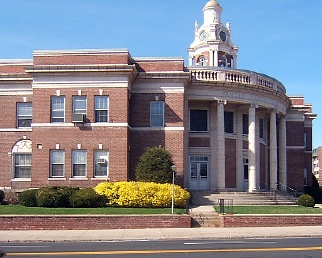In Your 'hood
February 27, 2006
Hogan's
Heroes

A tree on Hogan X'd for the ax.
People who live along scenic
Hogan Road are fighting Big Development
Story and photos by Sharon Bass
The boundaries of Hamden (physical, not ethical)
are on trial on Hogan Road. So is history. Or the importance thereof.
A five-house development called Blue Haven Estates
is about to break ground off Hogan Road, just over the border
in North Haven. Because the project is within 500 feet of the
Hamden line, it needed Hamden approval, said Assistant Town Planner
Dan Kops.
So last summer Jim Antanucci, the owner/developer
of the subdivision, got Inland Wetlands and Watercourses approval.
And that's when the boundary confusion was discovered. (A message
left for Antanucci was not returned.) Nobody can say which town
owns one particular portion of the road needing widening. Both
towns' engineers are currently scrambling to figure it out.
North Haven's approval of the subdivision requires
widening part of Hogan Road -- which is off Mt. Carmel Avenue
and called Brewster Lane in North Haven -- to increase the visibility
or the "sight line" of the road for safety reasons.
Boundary, Shmoundary
Drawing the line, however, will not do much for
the people who live in the neighborhood on both the Hamden and
North Haven sides. They say they moved there at least in part
because they love narrow, bumpy Hogan, which is a designated scenic
road. Developing it will draw more cars, especially from Quinnipiac,
and forever destroy the natural history of the road.
Last Tuesday, they presented a petition against
the widening to the Planning section of the P&Z Commission.
About 31 signed and about 30 attended the meeting.
"It'll make it a nice highway. Can't you just
see it? Two wide sides," Ruth Lindenfelsor, 89, said sarcastically
during a phone interview. She's called Hogan Road home since 1977.
"And college kids going home this way. I would not like it.
It's a quiet road now. I'm sitting where I can look out on the
road and a car's not gone by while I'm talking to you. And it's
a quiet road. We're lucky, I think."
Lindenfelsor signed the petition.
"I really don't want to see this road change.
It's a beautiful road," said Donna Wade of Hogan Road. "One
of the reasons we bought property here is the road. There are
very few places like this. I know people say, 'What an awful road.
It's so narrow.' But I love it. I love the potholes. I think widening
the road and paving the road is going to bring traffic."
Wade signed the petition.
"It's just an open invitation to making cars
go faster," said David Apter, who lives at the corner of
Ridge Road and Ives Street in North Haven. "Brewster Lane
is already wider than the Hogan Road part because [Hogan] is a
scenic road. However, [Brewster is] still scenic and people walk
their dogs. It feels like country even though it's been built
up considerably. Part of the concern we all have is it's one of
the last places not to look like a typical housing development."
Apter signed the petition.
While public comment was not allowed at the Feb.
21 meeting, Planning commissioners took the petition seriously.
They denied the road-widening request because of the murkiness
around the town line and the fact that Hogan is a scenic road.
It also sent an unfavorable recommendation to the Legislative
Council. Since it's considered a "municipal improvement,"
said Kops, it needs Council approval.
As well as the widening, Kops said two mature trees
on the Hamden side would have to be yanked because of Blue Haven
Estates. That's also raising a stir.
"When you have a scenic road you can't cut
down trees," he said. "When it's designated scenic you
have to get Council permission to fix a pothole. There aren't
many scenic roads in Hamden."
"The commissioners seemed to have a really
good grasp of what the citizens want," said an Ives Street
woman who asked to be anonymous. "It's such a touchy issue.
The people who want to develop it are really heavily invested
into the project and here's something that could inflame things,"
she said explaining why she didn't want her identity disclosed.
"We're a little uncomfortable with the idea
that somebody on the other side thinks we ran to the media. We're
not against the development. We're against them cutting trees
down and widening the road," the woman said. "We're
concerned that Quinnipiac students will use it as a back road."
"I think you'd be inviting theft," said
Lindenfelsor. "New people coming through and going faster.
I wouldn't want to see two cars going 45 mph. But I won't be around
to see it. I figure I'm not going to see it paved."

Not in Apter's 'hood
Apter seems to love everything about the area --
and will fight to keep it the way he found it. When he was president
of the Sleeping Giant Neighborhood Association, he said, "We
were particularly concerned with this area which some call the
best-kept secret in this part of Connecticut."
He bought his home in 1969. The oldest part was
built in 1721; the newest in 1750 or 1760, he said.
"It's a typical white clapboard Colonial house
with barn and outbuilding. It's also interesting that it was built
in an area that was an Indian campgrounds, because we dig up arrowheads
and grinding stones and lots of oyster shells," said Apter.
On the Hamden side, he passionately pointed out,
are 19th-century barns that were converted into studios for the
late painter/stained glass artist John
La Farge.
"The area itself, the woods make it pretty
special. The North Haven town engineer wants to widen the road
at some point 3 feet and that will in effect change the character
of the place," said Apter. "People can do what they
want with their land but …"
Wade said neighbors are thinking of formally uniting
to fight the widening and slaughter of trees. "It depends
on what happens. We may," she said.
February 23, 2006
Mediation
for the Remediation
The state puts the brakes on rolling out
its cleanup plan for Newhall
By Sharon Bass
The Department of Environmental Protection had a
Dec. 31, 2005, deadline to finalize its remediation strategy for
the contaminated Newhall neighborhood. Missing the deadline, it
set a new one for the end of January.
That didn't happen, either.
DEP spokesman Dennis Schain said something has delayed
the process. Something called a lawyer.
"Several weeks ago, we were approached by a
law firm (McRoberts, Roberts & Rainer of Boston) representing
a group of residents hoping to develop enough interest in a mediation
process. To bring everyone together -- homeowners, Olin, town
of Hamden, the water company," he said.
They want mediation. Schain said the first mediation
meeting with the interested parties will be "as soon as it
can be scheduled. It's difficult to say at this point [exactly
when] because there are variables. We need to see if the mediation
process has promise."
He wouldn't say how much of the state's remediation
plan is written. But did say none of the recommendations have
been finalized and wouldn't disclose what they are. "We didn't
want to put out publicly our specific recommendations," said
Schain, because of the upcoming mediation process.
Of the 302 properties within the 2003 consent decree
area, 220 tested positive for contaminated material dumped years
ago by the Winchester gun factory. The dirty dirt was also found
behind the school and in the two neighborhood parks, Rochford
Field and Mill Rock Park.
"Clearly we are looking at doing what is appropriate
to clean the area and to remove contaminated soils," said
Schain.
"We will be ready to put out our recommendations
if that appears to be the best course of action, if the mediation
effort does not take root," he said. The DEP has been working
on the Newhall Remediation
Project since November 2002.
February 14, 2006
Neighborhood
Dreams

Ideas for the old middle school
from those who live nearby
By Sharon Bass
The middle school on Newhall Street will close its
doors for good this June. What will become of the 180,000-square-foot
building that sits on 29 acres of contaminated soil has not yet
been determined. Town officials say they are poised to listen
to what the people in the neighborhood want. The people in the
neighborhood say they want to be heard. And at the top of many
of their wish lists is a community center.
"I think that it should be a community center
that would cater to the whole community," said Aisha Elm
of St. Mary's Street.
"I'm bored out of my mind. I would love yoga
classes that are affordable," said Eileen Carey who's lived
on Winchester Avenue for 38 years.
"We want it to turn into some community facility
that will benefit all of Hamden. Like the middle school was, everybody
came from all over Hamden," said Abdul Hamid of Augur Street.
Economic Development Director Dale Kroop said
last month that he is putting together a task force of business
owners, a Parks & Rec employee, folks from the Newhall area
and Councilpeople Willie Mewborn, 5th District, and Berita Rowe-Lewis,
3rd, to work with a consultant to figure out what to do with the
school. One thing it won't become is blighted property, he promised.
It will be redeveloped.
"That was my major concern about what they
were going to do. Are they going to leave an empty building?"
said Carey. "They've gotta do something good with it. They
can't just let it sit there. I think it would be great if we had
something for young people. Two community centers -- one for kids
and one for seniors.
Will we really be heard?
Hamid, a member of the Newhall Advisory Committee,
said he is skeptical about how seriously his neighbors' suggestions
will be taken.
"There should be a discussion on this,"
he said. "It will not just be turned into something that
becomes drug-infested and the problems of poor families. But they
(the state, the town) haven't listened so far" about the
cleanup of the area, which sits atop the former Winchester toxic
waste dump. Hamid and others want all the contaminated soil removed
and carted out of the area. The state has suggested removing some
of the soil and dumping it behind the old middle school.
"They pretend they are listening. But in the
end they do whatever they like and that is not very healthy,"
Hamid said.
Barbara Armstrong has lived on Newhall Street for
22 years and said she hopes she won't see year 23 at that address.
"Really, I'm trying to move out the area. I
have contamination in my yard," she said. But she was brimming,
nonetheless, with ideas for the middle school makeover.
Armstrong said she'd like to see an affordable apartment
complex and a community center "because the kids don't have
anything to do. Maybe a restaurant, too. Like a Ruby Tuesday or
something."
Some said they didn't even know the middle school
was closing.
"I didn't have the slightest idea," said
Madie Barrett of Winchester Avenue.
Ditto for Donald Broadnax of Morris Street. Asked
what he wants to replace the school, he echoed, "It should
be a community center." And then he elaborated.
For starters, he is retired but said he would like
to rejoin the workforce. "I need a job. It'll keep me out
of mischief. It would give me an opportunity to socialize and
chat with people.
"A lot of the people who live in the immediate
area are senior citizens and it would be an area to meet and play
pool," Broadnax said. "Kids could come and play basketball
-- under supervision of course. Some of the profanity you hear
is ridiculous."
Pamala Moore of Marlboro Street works at the Keefe
Center for the state Department of Environmental Protection's
Newhall Remediation Project. A lifelong resident of the area,
she rattled off a long wish list for the middle school site.
"I want it to be a culture center. What I want
in it is a café restaurant. I want a theater. I want a
senior citizen center. I want an office for the handicapped. I
also want a tourism office for the town of Hamden. In the back
there, I want a skate park for the young people that have skills
in that area. We could throw major competitions. I want to see
a handicapped park with low basketball hoops and organized teams.
I want an intermix of people and cultures involved in this center,"
said Moore.
Carey said she'd "love it" if adult ed
classes were offered. "They did all that renovation in 1989
[after the tornado]. It would be a deplorable waste of money"
if the school was razed. "It should be a place where people
can meet each other. It would be fantastic," she said.
No retail, please
A retired New Haven teacher, Pearl Mitchell of North
Sheffield Street said she envisions a place that offers performing
and fine arts classes, a gallery, after-school tutoring, mental
health and drug counseling for children and parenting classes.
"It's so needed. I wish the government could
say that if you have children in school, you have to go to these
classes. I think it would make children happier," said Mitchell.
"I see parents shouting at children and it's just awful."
The former educator said many students are in need
of tutoring but can't get it. "The children whom I taught
who were in grade three were reading on a grade one level,"
Mitchell said. "In all the years that I taught, I realized
the children needed tutoring but many of the parents couldn't
afford it."
One thing Mitchell said she doesn't want to see
is shops. "This is a residential area. Stores would just
offend the people," she said.
January 20, 2006
Give
Us a Break
Newhall residents made it clear
last night they want tax relief for the contaminated landfill they
live on
By Sharon Bass
Those living atop Winchester Guns' toxic legacy are
pushing for a blanket property rebatement because of what's below
the property they own.
"Everybody is in the same boat," said Abdul
Hamid during last night's Newhall Advisory Committee meeting. The
group meets monthly in the Keefe Community Center. Sitting with
Hamid on the committee are mayoral aide Scott Jackson, community
activists Pam Moore and Elizabeth Hayes, residents Herman Alexander
and Henry Platt, state Rep. Peter Villano (D-Hamden) and others.
New Haven attorney Kathleen Conway runs the meetings.
People from the state Department of Environmental
Protection, the Regional Water Authority and Olin Corporation (owner
of Winchester) are present at these meetings. They are all players
in the long-overdue, controversial massive cleanup the Newhall area
is to get -- the tab to be split between the state, RWA, Olin and
the town.
Everyone is listening.
Jackson told Hamid that state law does not allow towns to give
blanket abatements.
Hayes disagreed. She said there's a provision for that in the Connecticut
general statutes. "It's a good statute. I've read it for five
years," she said.
Villano said he was unaware of that law and would look into it.
Otherwise, he said, "there'd have to be special legislation
passed."
"There is already a state statute," Hayes shot back.
"Should we talk to the governor?"
"Only to sign the bill," said Villano. He said such a
law would be costly.
Meanwhile, Jackson explained how to apply for individual property
abatements by filling out a certain form by Feb. 20. "If there
are structural problems that would make a home worth less,"
he advised, apply for an abatement, especially in light of the recent
property revaluation, which doubled assessed values.
Moore said the abatement should also be based on the condition
of one's property. "I have contaminated land," she said.
"I wouldn't necessarily say that the land is the problem because
you won't have as strong a case" for an abatement, Jackson
said.
"But my problem is the land," said Moore, adding that
its value rose the same amount as her house did.
"You have to find the things that make your property worth
less," said Platt.
Alexander revived the argument for a blanket abatement saying the
properties are worth less because of the widely known contamination.
Committee members who live in the consent decree area said they're
not allowed to have gardens, dig up their yards or install swimming
pools.
"If you have to flag your house as contaminated (when the
remediation begins), it does affect all of the properties as well,"
said Alexander.
"It sure does," said Jackson. "And should that happen,
it would definitely be looked into."

Mayoral aide Scott Jackson
Jackson then talked about the fate of the old middle school, which
is also on contaminated soil.
"What are we going to do with this 180,000-square-foot building?
Everything is on the table," he said. "Our commitment
is to the people in the Newhall neighborhood."
Yesterday was due day for bids from contractors interested in transforming
the school, said Jackson. Four or five came in. Bidders were asked
to describe their backgrounds and qualifications for such a project
and to give a cost estimate. Jackson said they were not asked for
project ideas, as those are to come from the people in the neighborhood
and other stakeholders.
He said he's nearly finished assembling a panel of five to seven
members who will review the contractors' applications and make a
decision. He said residents, business owners and a Parks & Rec
person will be on the panel.
"I wasn't asked," said Hamid.
Jackson told him the members were all handpicked.
"You picked the ones you like," Hamid said.
"We have every confidence that this panel will not be good
-- it will be great," responded Jackson.
Kelly McCarthy, a Green who ran an unsuccessful but strong race
for the 5th District Council seat last November, was at the meeting.
Asked for comment afterwards, she said, "The residents of the
Newhall community have been waiting for over five years for promises
to be fulfilled and for something to be done about the decades-old
contamination that has labeled the neighborhood a 'brownfield.'
"The EPA defines a brownfield as a 'property on which expansion,
redevelopment or reuse may be complicated by the presence, or perceived
presence, of contamination.'
"I don't think many people would argue against assisting those
who've suffered physical property damages, but the entire community
has and will continue to suffer both psychologically and financially
from the stigma of contamination," said McCarthy. "There
is a national precedent for providing blanket tax abatements to
residential property owners in areas known to be contaminated or
recently remediated, one example being in Fort Wayne, Ind. Providing
some tax abatement seems like the least we should be doing to assist
our neighbors in this unfortunate situation."
January 6, 2006
Getting
it Off Their Collective Chest

Helen Sherman was one of many to take the mic
last night.
Folks vented at a three-hour
public meeting about the troubles they've had with Quinnipiac students
who live among them
Story and photos by Sharon Bass
When state Rep. Brendan Sharkey (D-Hamden) opened
last night's packed forum on Quinnipiac students who live off campus,
he mentioned the good and the bad of the university.
He said Quinnipiac has "irresponsibly" enrolled
too many students for whom there is not enough on-campus housing,
and does not respond to the community's complaints. He then shared
with the 400 people who filled Thornton Wilder Hall his own trials
and tribulations with the university.
"I'm a veteran of this issue," said Sharkey,
who lives on Mt. Carmel Avenue. "What we were experiencing
10 to 12 years ago is (now) being felt around town."
The audience was with him.

It was a packed house at Thornton Wilder Hall
last night.
But when the three-term legislator pointed out some positives about
Quinnipiac -- "I have not heard a single resident say to me
that Quinnipiac is not an asset, with its cultural offerings. Its
architecture is beautiful" -- the crowd grunted.
So was the mood for the cathartic evening entitled, "Quinnipiac
Off-Campus Housing: Its Impact on the Community." It was organized
by Concerned Citizens for Hamden Neighborhoods, a new coalition
spearheaded by Joanne Iacobellis of Kenwood Drive.
Folks lined up behind three microphones to speak their minds and
pour out their feelings about what it's like for them to live among
students, and how Quinnipiac officials systematically ignore their
pleas to find solutions.
They were angry. Frustrated. Scared.
One by one, they told stories of speeding cars, all-night drinking
parties, loud music, car doors slamming in the wee morning hours,
beer cans and other litter on their property and in their streets,
six to eight kids living in a house, when town ordinance says only
four unrelated adults can inhabit the same home, and a university
that has turned a deaf ear on them.
And some expressed gratitude for the public forum. "I'm so
thankful that you're doing this tonight," said one woman.

Don Werner asked to speak to a ghost.
"The question I have is directed toward the representative
from Quinnipiac," Don Werner, a longtime Hamden resident and
town employee, said rhetorically.
He knew, as did most of the crowd, that no one from the university
showed.
"That's all I have to say," said Werner as he stepped
away from the mic.
The audience applauded.
Iacobellis whispered to the HDN that she had e-mailed notice
of the forum to Quinnipiac public relations director John Morgan,
but had gotten no response.
In a statement e-mailed to the HDN late yesterday, Morgan
wrote: "University officials recently met with the mayor and
his chief mayoral aide and we're looking forward to working out
a resolution to the perceived problems with off-campus housing.
The issues brought forward at the meeting tonight involved mostly
houses owned by private landlords whom the university has absolutely
no control over. We look forward to continuing to work with the
mayor toward a resolution."
Fred McCarthy of West Todd Street told the crowd how he felt about
sharing his street with students. "I get pretty tired of picking
up trash all the time. But my main concern is (the impact of the
students) on police and fire. We can't afford it."
Sharkey, Mayor Craig Henrici, Councilman Matt Fitch and neighborhood
activist Les Faiman sat at the front of the auditorium, listening
to the grievances and occasionally responding.
Sharkey explained the state gives Hamden PILOT dollars (payment
in lieu of taxes) since Quinnipiac's real estate holdings in town
-- over $86 million in 2004 -- are tax-exempt. However, the PILOT
program gives 30 percent to 35 percent less than what the actual
property taxes are. "And not a dime of that comes from Quinnipiac.
That money is coming from all of us," he said.
The audience clapped.
He said in other college towns arrangements are made where the
school compensates the community in a variety of ways for not paying
taxes. "That is something we can suggest to the mayor and Council,"
said Sharkey.
A man from West Todd Street stood before a microphone. He held
a paper bag. He walked onto the stage and dumped the bag's contents:
a single beer can. Returning to the mic he said, "I can't say
this was dropped by Quinnipiac students, but a car with New York
license plates" came barreling down his street and threw the
can out the window.
The audience roared.
He said the student caught firing a shotgun in a back yard last
year is his neighbor. "There is screaming and yelling constantly
at 3 o'clock in the morning because the bars get out at that time,"
the man said.
The audience applauded.
"The cars not only go off the roads, they go through the bushes,"
the man from West Todd Street added.
A woman said she called the university after the infamous Halloween
party bust last October at a student home on Whitney Avenue. "What
I heard was those are not our houses, contact the landlord,"
she said. "I don't know the landlord."
Helen Sherman of Amherst Street said she spoke several times with
Hamden's previous town planner about her dilemmas with the students
next door, and was told nothing could be done about it. "We're
screwed," she told her peers.
Donna Wilson of Forest Street also talked of failed attempts to
get resolve from the Planning Department. Her gripe was about students
parking their cars "everywhere. It got so bad they parked on
the yard of the woman across the street," she said. "We
sent pictures to Zoning and the comment we heard was, 'We aren't
sure if those cars belong to people living in that house.'"
Furthermore, Wilson said, she's awakened every two hours by noisy
students. She said they are as arrogant as the university officials.
"Their attitude is, 'We pay our $35,000. We'll do what we want.'
I'm sick of it. I can't sleep anymore," she said.
The crowd moaned with empathy.
On a wall were huge sheets of papers listing off-campus student
houses -- those owned by Quinnipiac and private investors. All evening,
people eagerly penciled in houses not on the list:
52 Riverside Drive
16 Gateway
58 Broadway
61 Linden Avenue
69 Eramo Terrace
136 Cannon St.
5 Costanzo Court
300 Fans Rock Road
25, 99, 123, 142, 152, 160, 188, 355, 385, 475, 560 and 660 New
Road
3085, 3151, 3159, 3165, 3185, 3449 and 3455 Whitney Ave.
A Realtor who lives on Kenwood Drive said people buy $300,000 homes
from him "and there's no way they can put four kids in there
and pay the mortgage. They have to put in seven kids. They're taking
advantage. Why can't we enforce" the four-unrelated-people-in-a-house
rule?"

Spencer Adams wants speed bumps.
"Why can't we put speed bumps in?" asked Spencer Adams
who's lived on New Road for 30 years. "It's done all over the
state. I was told by (the town) we can't do that." He said
he's contemplating moving.
"Our neighborhood is not a neighborhood anymore," said
another.
"Will they put up a dorm on our street?" a New Road rezzie
asked nervously. "They've taken an entire neighborhood and
turned it into theirs. It's criminal! It's criminal!"
The audience roared.
"Quinnipiac has become a thorn in our side!" bellowed
former Police Commissioner Neal Longobardi of Renshaw Road. "We
should become a thorn on their side!" He urged people to find
out who owns the student homes in their area "and call them
at 2 a.m. Inundate them with calls!"

Landlord Jacob Bergman doesn't want to know.
While no one from Quinnipiac was present, one landlord of student
housing attended the forum. Jacob Bergman, a '99 grad of the university,
said he owns 13 houses in town. When asked by the HDN if
he rents them to students he said, "I don't know. It's none
of my business."
Bergman, 30, lives in Manhattan where he is a hotel developer.
He said he also "lives" part-time at 3321 Whitney Ave.,
where he said he has an office and students living. Asked if he
checks references, credit and income of his tenants, he consistently
replied with, "I have my own application. I do a good job with
what I do. Pointing fingers isn't going to help."
What will help? What can realistically be done about a school that
has seen a 40.5 percent increase in enrollment between 1995 and
2004? A school that is short 2,464 student beds? A school that shows
no signs of slowing down growth?
Quinnipiac needs to willingly come to the table, Sharkey said after
the meeting. But even with a court mandate to do so, the school
has not complied.
In 1999, the Sleeping Giant Neighborhood Association, of which
Sharkey is a member, appealed a town decision to allow Quinnipiac
to build a parking lot between Whitney Avenue and New Road, where
a former tree farm was. The basis of the appeal was the parking
lot would not be connected to any of the university's property.
While the appeal didn't work, the court approved an agreement between
the town, the Sleeping Giant Association and Quinnipiac that says
"the school would agree to meet with neighborhood groups at
any time in respect to their plans for development," the state
rep and land-use attorney said.
Though it's a legally binding agreement, Sharkey said Quinnipiac
has not followed through on its promise.
What's left, besides community pressure and persistence, is going
after the university's reputation. Bad publicity, such as what came
out of last night's seminar, is not good for its financial health.
"They don't want that reputation," said Sharkey.
From the sound of things, it might be too late.

















